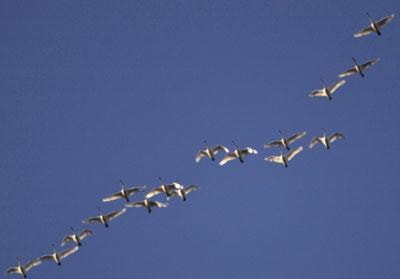Instead of flying south to paddle in clement climates, some lazy swans haven’t left the territory this year.
“If there’s open water and food, there will be swans,” said wildlife-viewing biologist Bruce Bennet.
But trumpeter swans in January are a relatively new Yukon phenomenon.
Five or six years ago, the elegant white birds were spotted at the southern end of Teslin Lake and at the Francis Lake outflow, in the middle of winter.
“There are swans on the Teslin River at Johnson’s Crossing too,” said Bennett.
And in January, someone in Teslin counted five swans under the bridge, he said.
“They have been turning up in our Christmas bird count.
“And that’s too early for the northern migration, so some must be overwintering,” said Bennett.
Last winter, residents counted eight swans by the Teslin bridge—four adults and four young.
But in late February, one of the youngsters met a bloody end.
“It was a battle,” said Bennett.
“A coyote or a wolf got one, you could see the canine’s tracks—it was a big fight.”
Bennett has also found swan carcasses curled up on the ice during early spring trips down the Yukon River.
“There’s usually nothing left but the bones,” he said.
But it’s unlikely they froze, he said. Yukon winters shouldn’t have much of an impact on the majestic birds.
“Cold isn’t a big thing when you’ve got a down jacket on,” said Bennett.
“And it’s always warmer where there’s open water—there’s latent heat.”
Bennett has watched mergansers and dippers overwinter by ducking under the ice when temperatures plummet.
The water drops and leaves a space under the ice, he said.
“And the temperature is usually just above zero under there.”
The swans are feeding off pondweed.
“They eat the roots—it’s like potato spaghetti,” said Bennett.
“They eat all manner of aquatic vegetation, but no fish.”
In the early part of the century, swans were hunted for their feathers and skin. And their eggs were collected, said Bennett.
By the 1920s, swan populations hit an all-time low.
“They thought trumpeter swans were extinct,” he said. “Then they found a group of them on Vancouver Island.”
After swans were protected, and people stopped harvesting the birds and their eggs, the species began to bounce back.
As the swan population expands, so do their wintering areas, said Bennett.
“But we don’t know how far north they overwintered traditionally, because swan populations were so low.
“Now we’re seeing populations we haven’t seen in a century, so we may just find they’re expanding into their traditional overwintering areas.
“It’s not necessarily anything to do with climate change,” he said.
Usually in April, once the ice starts breaking up, the swans begin migrating north and west.
The swans wintering in the Teslin area will head up to Mayo and the Dempster, said Bennett.
Those that stop for a breather at Swan Haven fly on to Alaska via Kluane Lake, and the Donjek River, before landing in and around Tok.
Contact Genesee Keevil at
gkeevil@yukon-news.com
